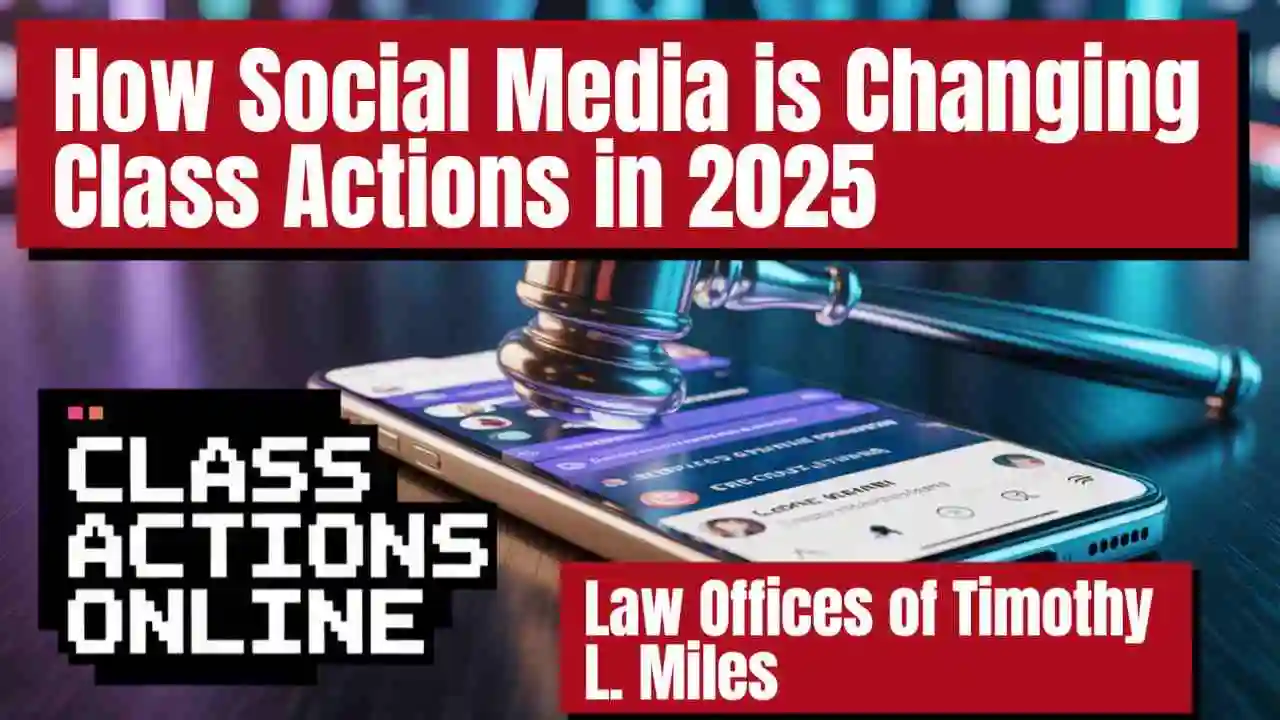Introduction to Class Action Lawsuits and Social Media

Class action lawsuits have hit social media giants in an unprecedented wave on a daily platform where users exceed 5 billion people—representing over 60% of the world’s population.
Lawsuits against social media have grown dramatically, and major social media companies now confront intense litigation and regulatory oversight, especially when it comes to young users’ mental health.
These class action lawsuits against social media companies have become a crucial legal battleground that shapes platform operations and helps affected users seek justice.
The most controversial claims suggest companies deliberately created addictive platforms that target children and teenagers. California’s courts serve 39 million people and handled 4.5 million cases during fiscal year 2021-2022.
This legal revolution will likely set new standards for class action lawsuits in 2025 and beyond.
This piece gets into how social media class action lawsuits against social media continue to evolve, what drives these cases, and what you need to know about joining such litigation. The ongoing class action lawsuits might reshape our daily digital world completely.
What is a Social Media Class Action Lawsuit?
Lawsuits against social media have changed dramatically. Thousands of people now unite to hold tech giants responsible for alleged harm. A social media class action lawsuit happens when people who faced similar damages from a social media company’s harmful practices sue together instead of alone. This legal approach gives strength against powerful corporations. It cuts down individual legal costs and keeps legal rulings consistent.
Definition and how a Social Media Class Action Lawsuit Works
People who face similar harm from social media platforms can join under one legal action. Courts must give “class certification” to recognize them as a unified group with similar claims. Class representatives support all members throughout the legal process. These representatives are usually people who faced the most important harm.
These new class action lawsuits include different legal grounds. Claims range from negligence to product liability and violations of consumer protection laws. The plaintiffs claim that platforms are dangerous by design. They also say social media companies failed to protect users, especially young people who just need extra protection.
The cases have grown fast. The Social Media Addiction MDL (Multidistrict Litigation) now has 1,922 active lawsuits as of August 2025. This united approach helps handle many similar claims against industry leaders efficiently.
Why social media platforms are being targeted in class action lawsuits
Social media companies face a huge wave of lawsuits. Plaintiffs claim these platforms encourage engagement to maximize addiction while hiding mental health effects. Whistleblowers leaked internal documents that showed some companies knew their products were addictive. Yet they chose profits over user safety.
The class action lawsuits, target these problematic design elements:
- Algorithms that drive compulsive use and create “rabbit holes” of harmful content
- Never-ending feeds built to keep users scrolling
- No proper warnings during sign-up
- Poor tools to track and limit usage
- Roadblocks to account deletion
- Weak age checks
- Limited parental controls
Research shows too much social media use leads to serious mental health problems. Depression, anxiety, eating disorders, and suicidal thoughts affect teens the most. Families, school districts, and state governments now work together to demand change.
Examples of recent lawsuits against social media
The digital world of social media faces more legal challenges. Attorneys general from 42 states have filed lawsuits against social media. They claim companies hid dangers while profiting from children’s pain.
Judge Yvonne Gonzalez Rogers made a key decision. She picked six school districts nationwide as test cases against major platforms. These districts, including Harford County Public Schools, say social media companies built addictive platforms. These platforms cause widespread student mental health problems. The first trials should start in 2026.
A family from Kettering, Ohio sued Meta and Snap for their 16-year-old child. They claim the platforms caused serious mental health issues. Their child showed compulsive use, depression, anxiety, and self-harm. A California family also claimed their child suffered severe psychological injuries. These included addiction, depression, and attempted suicide from harmful content exposure.
The lawsuits gained strength after a crucial ruling. It allowed negligence and wrongful death claims against major social media companies to move forward. The ruling rejected First Amendment and Section 230 defenses. This legal breakthrough showed that public policy supports making social media companies protect young users.
Top Legal Claims in Social Medial Class Action Lawsuits 2025

Social media giants face a wave of class action lawsuits that have altered the map of legal accountability in 2025.
Courts throughout America now weigh these claims, and four key allegations stand out as major forces shaping digital responsibility.
Mental health harm to youth
Youth mental health crisis leads the social media litigation trends. A groundbreaking case shows attorneys general from 33 states suing Meta. They claim the company “profited from children’s pain” through addictive features that damage young users’ mental health.
These new class action lawsuits draw parallels between social media companies and “big tobacco and vaping companies,” claiming they “chose to maximize profits at the expense of public health”.
Frances Haugen, a former Facebook employee, gave crucial congressional testimony that changed everything. She revealed Meta’s internal research linked Instagram to serious mental health issues, yet the company reportedly hid these findings. Current litigation claims social media causes:
- Depression and anxiety disorders
- Body dysmorphia and eating disorders
- Self-harm behaviors
- Suicidal ideation and attempts
The U.S. Surgeon General now labels social media a “public health hazard”, which strengthens these legal claims. School districts spend over $100 million each year to address youth mental health problems that these platforms reportedly make worse.
Data privacy violations class action lawsuits
Data privacy violations make up the second major category of class actions. AT&T settled for $177 million after data breaches affected 73 million customers. Customers might receive up to $7,500 in damages, though actual payments could vary.
Children’s Online Privacy Protection Act (COPPA) violations have sparked substantial litigation. Companies face charges of collecting personal information from users under 13 without parents’ permission. Google paid $30 million to settle a YouTube privacy lawsuit about tracking children’s data for targeted advertising.
These privacy cases grow as plaintiffs use old state and federal wiretap laws against modern digital tracking technologies.
Algorithmic manipulation and addiction
Class Action Lawsuits 2025 now targets platforms’ user manipulation through engineered algorithms. Legal documents claim social media companies promote compulsive use through:
Algorithms that push engaging content “Infinite scroll” features that keep users hooked Constant alerts that demand attention Visual filters that distort body image “Likes” and social comparison tools that hurt young people
Minnesota wants up to $25,000 for each time a child accessed TikTok. Courts now view these claims as product liability cases, treating algorithms as potentially faulty products.
Consumer fraud and deceptive practices allged in lawsuits against social media
Deceptive business practices round out the major claims. The FTC gave out $8.1 million to consumers hurt by Care.com’s misleading claims about earnings and job listings. Influencer marketing has triggered many class actions about hidden paid endorsements that might count as consumer fraud.
Platform safety misrepresentation brings extra scrutiny. Class action lawsuits claim Meta and others publicly denied what internal documents showed: young children made up much of their user base despite age limits.
Section 230 of the Communications Decency Act once protected platforms from content liability. Courts now allow claims about platform design rather than user content. This legal shift gives plaintiffs a significant breakthrough in holding social media giants accountable.
Major Platforms Facing Lawsuits Against Social Media

Social media giants face a wave of lawsuits as attorneys general, school boards, and private citizens team up to hold these companies responsible for alleged harm.
The legal scene has changed a lot since 2023. Record-setting settlements and new legal theories have altered the map of digital accountability.
Meta (Facebook, Instagram)
Meta sits at the center of social media lawsuits, with 33 attorneys general filing a federal social media class action lawsuit that claims the company created features to hook children and teens.
This group says Meta “profited from children’s pain” through Instagram and Facebook’s manipulative features that hurt young users’ mental health.
The lawsuit points to algorithm-based recommendations, “likes” features, constant alerts, and visual filters that lead to body image issues.
Meta also settled a multibillion-dollar lawsuit with shareholders over privacy issues tied to the Cambridge Analytica scandal. The settlement dealt with claims that executives didn’t reveal risks to users’ personal data, which the political consulting firm supporting Donald Trump’s 2016 campaign later misused. Investors wanted about $8 billion back for fines and legal costs from this scandal.
The company paid $1.4 billion in 2024—the biggest privacy settlement a single state has ever gotten—to resolve claims it took biometric data from millions of Texans without proper permission.
TikTok
TikTok battles its own wave of class action lawsuits about its data collection methods. The company paid $92 million in 2021 to settle class action claims about collecting user data without proper consent, including sensitive biometric information. This settlement affected all U.S. residents who used TikTok before September 2021 and an Illinois subclass of users who made videos on the platform.
Thirteen states and the District of Columbia sued TikTok for allegedly taking children’s data against COPPA rules. The U.S. Department of Justice filed similar charges in August 2024.
The platform’s content monitoring also raises concerns. Italy fined TikTok €10 million ($11 million) in March 2024 because it didn’t stop harmful content, including the “French scar” challenge that put minors at risk.
Snapchat
Snapchat deals with over 1,900 cases in a multidistrict litigation about teen addiction. Parents claim the platform’s features—like disappearing messages, beauty filters, and “Snapstreaks”—create compulsive use and damage teen mental health.
The California Civil Rights Department got a $15 million settlement from Snap Inc. over sex-based job discrimination claims. The settlement addressed women’s complaints about hitting a “glass ceiling,” facing sexual harassment, and getting pushback when they spoke up.
Fourteen Ontario school boards can now sue Snapchat and other platforms after a judge backed their case. These schools say the apps are “negligently designed for compulsive use” and have “rewired the way children think, behave and learn”. They want more than $8 billion in damages.
YouTube and Google
Google will pay $30 million to settle a long-running class action that accused YouTube of illegally collecting children’s data for targeted ads. The lawsuit claimed Google broke dozens of state laws by letting content providers “bait children with cartoons, nursery rhymes and other content” to collect data.
The proposed class includes U.S. children under 13 who watched YouTube between July 2013 and April 2020—possibly 35-45 million members. This follows Google’s earlier $170 million payment to the FTC and New York Attorney General in 2019 for similar issues.
These legal fights show a fundamental change as courts now reject platforms’ immunity defenses. This could reshape how social media companies design their products and work with users, especially young ones.
How Social Media is Changing the New Class Action Lawsuits
Social media has changed how class action lawsuits work beyond courtroom allegations. The digital world has changed evidence collection, jury selection, and case outcomes in ways lawyers of the past never imagined.
Digital evidence and discovery
Social media platforms now offer a wealth of vital evidence in legal proceedings. Courts let lawyers access social media information more often when they can show it matters to their case. A New York court allowed access to a former athlete’s private social media accounts to get photographs that went against disability claims after a car accident. The court set smart limits on time and subject matter to stop random searches.
Digital forensics preservation plays a key role in modern litigation. Simple screenshots are not enough as valid evidence anymore. Lawyers must use special tools like X1 Social Discovery and PageVault to capture visible content and hidden metadata. These tools create cryptographic hash values (digital fingerprints) that prove data stays unchanged, which helps evidence meet court standards.
Juror exposure and bias
Juror behavior in the social media age raises serious concerns. Research shows 46% of potential jurors say they would look up a defendant on social media during jury duty. Legal experts think this number is much higher because people find it hard to resist the temptation.
This behavior can lead to serious problems. The Arkansas Supreme Court threw out a capital murder conviction in part because a juror kept posting Twitter updates during the trial despite warnings. The court decided this was “juror misconduct that calls into question the fairness of the trial.”
Public opinion of Lawsuits Against Social Mediaand trial outcomes
The Depp v. Heard defamation case shows how social media affects trial outcomes. Depp lost in London but won his U.S. trial amid massive social media attention. A hashtag supporting Depp got 20 billion views on TikTok while Heard’s only reached 7.5 million.
Fans showed up outside the courtroom each day, creating an atmosphere that could have swayed non-sequestered jurors.
Social media fills up with unqualified “armchair experts” who share theories about ongoing cases. One legal expert pointed out, “None of these people can be subject to cross-examination in a courtroom”. Still, their collective voice shapes public opinion substantially.
Real-time media coverage and its effects
Up-to-the-minute commentary on Twitter and TikTok creates “echo chambers” where people reinforce each other’s views. This often leads to strong opposing opinions about ongoing cases. Cases with racial, political, or social elements face special challenges.
Courts now adapt their jury selection process. The American Bar Association suggests tougher voir dire questioning that looks at potential jurors’ media habits. This helps identify and remove biased jurors through detailed questions about their media consumption patterns.
The rise in class action lawsuits against social media companies comes with an interesting twist – these same platforms change how these legal battles play out.
The Role of California in Lawsuits Against Social Media
California leads the nation in social media class action lawsuits. The state’s courts shape digital accountability across America. This unique mix of strong consumer protection laws and tech company headquarters makes California the perfect testing ground for landmark cases.
Why California is a hotspot for tech litigation
Silicon Valley and countless tech giants call California home, which naturally draws litigation their way. The state’s massive population and tech-driven economy make these legal battles more significant. Courts in Los Angeles, San Francisco, and other California jurisdictions lead the way in tech accountability rulings.
These venues have become the go-to choice for legal teams seeking justice.
Two California courts now handle key test cases that have entered the discovery phase. The Federal District Court for the Northern District of California and the Superior Court for the County of Los Angeles will begin trials scheduled to begin in 2025. These cases will likely set precedents that affect social media rules nationwide.
Key laws supporting plaintiffs
California’s legal system gives plaintiffs powerful tools through consumer-friendly laws. The California Unfair Competition Law (UCL) and Consumer Legal Remedies Act (CLRA) let lawyers create innovative strategies against questionable business practices. The state stands out because plaintiffs don’t need to prove companies meant to deceive consumers – there’s no scienter requirement.
The state has strengthened these protections with new social media platform laws. SB 976 (Protecting Our Kids from Social Media Addiction Act) limits youth exposure to addictive content without parent approval. New rules also demand more transparency in content moderation and better online privacy protection for children.
Notable class lawsuits cases from California
Several California counties have sued major platforms for public nuisance. San Diego, Sacramento, and Del Norte Counties claim that Meta, Snap, Google, YouTube, and TikTok used “behavioral and neurobiological techniques” to make minors use their platforms compulsively. San Mateo and San Diego counties joined Sonoma County in a federal lawsuit that accuses social media giants of breaking the Federal Racketeering Act.
Beasley Allen law firm represents thousands of people and hundreds of school districts in early discovery cases. They handle 10 out of 21 personal injury cases chosen in Los Angeles Superior Court. These cases target harm from algorithmic design rather than user content. This approach might bypass traditional immunity defenses.
What Plaintiffs Should Know Before Joining a Lawsuit

Careful preparation will strengthen your case and protect your rights when you join social media class action lawsuits. Anyone who wants to be part of these high-profile legal battles should know the key steps that will affect their chances of success.
How to document your experience
Anyone who wants to join lawsuits against social media must preserve evidence properly. Your first step should be to secure digital records showing platform usage patterns that prove addictive behavior.
Medical records with diagnoses and treatments linked to social media addiction serve as vital proof of harm. Parents need to track their children’s behavioral changes, including personality shifts, grade changes, and mental health issues.
Your case becomes stronger when you keep chronological records that show how symptoms and treatments progressed, which proves the connection between platform use and mental health problems.
Finding the right legal representation for Lawsuits Against Social Media
You need attorneys who practive in mass torts such as Timothy L. Miles, consumer protection, or technology law to navigate class action lawsuits 2025. Most firms that handle social media cases work on contingency fees. This means you pay nothing upfront—attorneys get paid only when they win compensation.
Law firms usually offer free case evaluations to help you learn if you meet the requirements to join the litigation. Expert lawyers will help you calculate potential damages, including medical costs, pain and suffering, life quality losses, and career impact expenses.
Understanding your rights and risks
Your case must meet specific court-mandated eligibility criteria. New class action lawsuits with social media addiction typically include platforms like Meta (Facebook/Instagram), TikTok, and Snapchat. Class members have limited control over litigation strategy and settlement talks compared to lead plaintiffs.
Any settlement you agree to will bind you legally and might restrict future legal action. Time limits exist for joining these lawsuits, so talking to a lawyer quickly will protect your right to sue.
Conclusion
Class action lawsuits against social media companies mark a radical alteration in how our legal system holds tech giants accountable. These landmark cases show, without doubt, a new era where platforms can not hide behind Section 230 immunity because their design causes harm.
Major social media companies face mounting evidence against them. Youth’s mental health problems, data privacy violations, algorithmic manipulation, and deceptive practices are the foundations of thousands of active class action lawsuits. California’s courts have become the battleground where these cases will set precedents that affect digital regulation across the nation.
Social media also reshapes the scene of the legal process. Today’s attorneys face challenges their predecessors never imagined – from collecting digital evidence to managing juror exposure and live commentary.
People who want to join such litigation need proper documentation and experienced legal representation. Class members should weigh their rights and learn about potential outcomes before moving forward.
Social media companies will fight hard against these claims, but the legal tide shows signs of turning. Courts now see platforms as products with potential defects instead of neutral forums for user content. This difference changes everything about liability.
These cases mean way beyond the reach and influence of monetary settlements. They will alter how social media companies design products, protect user data, and safeguard vulnerable populations—especially children. We face a digital reckoning that will shape how technology and society interact for generations ahead.
Key Takeaways
Social media class action lawsuits are fundamentally reshaping digital accountability as courts increasingly hold tech giants responsible for platform design rather than just user content.
• Mental health claims dominate 2025 litigation: Over 1,900 cases target platforms for allegedly designing addictive features that harm youth mental health, with 33 state attorneys general suing Meta alone.
• California leads the legal charge: The state’s consumer-friendly laws and tech concentration make it the epicenter for social media litigation, with bellwether trials starting in 2025.
• Digital evidence requires specialized preservation: Standard screenshots no longer suffice—attorneys must use forensic tools to capture metadata and create cryptographic hash values for court admissibility.
• Social media transforms jury behavior: 46% of potential jurors admit they would research defendants online, forcing courts to adapt jury selection processes to prevent bias.
• Document everything before joining lawsuits: Preserve usage patterns, medical records, and behavioral changes chronologically to strengthen your case and maximize potential compensation.
These legal battles represent more than monetary settlements—they’re reshaping how platforms design products and protect users, particularly children, establishing precedents that will govern digital interactions for decades to come.
Contact Timothy L. Miles Today for a Free Case Evaluation About social media class action lawsuit
If your child suffered metal health issues from social media addiction, call Timothy L. Miles today for a free case evaluation. 855-846-6529 or [email protected] (24/7/365).
Timothy L. Miles, Esq.
Law Offices of Timothy L. Miles
Tapestry at Brentwood Town Center
300 Centerview Dr. #247
Mailbox #1091
Brentwood,TN 37027
Phone: (855) Tim-MLaw (855-846-6529)
Email: [email protected]
Website: www.classactionlawyertn.com
Visit Our Extensive Investor Hub: Learning for Informed Investors



